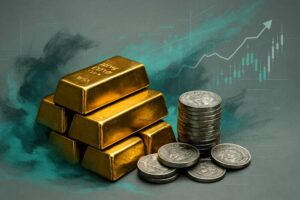Navigating the Precious Metals Landscape: Platinum, Palladium, and Beyond
Welcome to the Extreme Investor Network! Today, we dive into the fascinating world of precious metals—specifically platinum and palladium. While many investors instinctively gravitate toward gold, understanding the unique dynamics of platinum and palladium might just offer you an edge in your investment strategy.
The Price Drivers: More Than Just Gold
Unlike gold, which is influenced by a wide range of economic factors, the prices of platinum and palladium are significantly driven by automotive industry demand. With about 40% of platinum and 80% of palladium deployed in catalytic converters, there’s a direct correlation between vehicle sales and the prices of these platinum group metals (PGMs).
1. Automotive Demand: The Heart of PGM Prices
The automotive sector is a game changer for the demand for platinum and palladium. Platinum predominantly serves in diesel engines, while palladium is the go-to for gasoline vehicles. This important distinction created contrasting price trajectories, especially as diesel vehicles faced scrutiny after various emissions scandals. As environmental regulations tighten, PGM investors need to keep an eye on trends in the automotive landscape.
The 2023 Shift: An Unexpected Turn
In a noteworthy twist last year, platinum began replacing palladium in catalytic converters, leveraging a price gap that fell to approximately $900 per ounce. This swap represents not only an intriguing market dynamic but also a unique opportunity for astute investors to explore when considering supply and demand.
2. Supply Concentration: The Risks of Overreliance
Given that 70% of the world’s platinum is mined in South Africa and about 40% of palladium comes from Russia, supply concentration introduces significant risk into the equation. Geopolitical tensions or labor strikes can have a severe impact, leading to price volatility that savvy investors should be ready to capitalize on. Understanding the geopolitical landscape is essential in navigating these markets.
3. The Substitution Effect: A Market Adapts
One of the key aspects to watch is the substitution effect. Automakers can pivot between platinum and palladium based on relative prices, adapting their strategies swiftly to maximize profits. Keeping tabs on these substitutions could provide fabulous insights for market projections.
4. Future Technology Shifts: Are We Ready for Change?
The advent of electric vehicles (EVs) poses a critical question for PGM demand. Standard battery EVs do not require catalytic converters, potentially jeopardizing traditional PGM sales. However, hydrogen fuel cell technology, which utilizes significant amounts of platinum, could emerge as a new driver if it gains traction in the market.
Why You Can’t Out-Predict the Market
The complexities of the precious metals market mean that consistently beating professional analysts is a formidable challenge. Prices are constantly updated based on real-time information, with participants eagerly incorporating new developments.
When the Federal Reserve signals a potential rate change, you can bet that prices react almost instantaneously. For example, gold often jumps upon expectation of policy shifts rather than waiting for the actual changes.
As an investor, understanding your limitations is critical. Drawing from personal experiences—like the one with gold miners—you may realize that several factors could be working against you, such as:
- The market may already have priced in key economic risks.
- Your self-confidence can cloud your understanding of supply-demand dynamics.
- Timing can derail even the best-planned strategies.
Where Your Real Edge Might Be
If foreseeing macro trends isn’t your strong suit, don’t worry; your strength could lie in exploiting structural imbalances. Here are some recurring patterns to explore:
1. Seasonal Jewelry Demand
Seasonality plays a significant role in gold pricing, especially in major markets like India and China. Events such as the Indian wedding season (October to December) and Chinese New Year in January and February present opportunities as demand surges. Recognizing these patterns allows you to position yourself effectively ahead of market movements.
2. EFP (Exchange for Physical) Arbitrage
Market inefficiencies occasionally create distortions between spot prices and futures contracts. During times of disruption, such as the COVID-19 pandemic, arbitrage opportunities can emerge. Traders adept at capitalizing on these discrepancies can reap significant rewards.
3. Option Expiration Effects
The monthly expiration of options on precious metal futures leads to predictable hedging activities, which can create “price magnets” or “repellent zones.” While this may not offer overwhelming advantages, it’s a phenomenon that traders can study for potential insights.
4. Futures Roll Dynamics
The process of rolling futures contracts from one expiration date to another can cause notable price patterns that traders need to watch keenly, especially in silver markets where the liquidity differs from gold.
A Framework for Finding Your Edge
In conclusion, while the intricacies of investing in platinum and palladium can seem daunting, focusing on recognized patterns and structural imbalances may yield potential profits. Developing a keen awareness of seasonal trends, opportunities for arbitrage, and option expiration effects could set you apart from the average investor.
Stay tuned to the Extreme Investor Network for more insights on navigating the dynamic markets of precious metals and uncover new paths to profitability!

